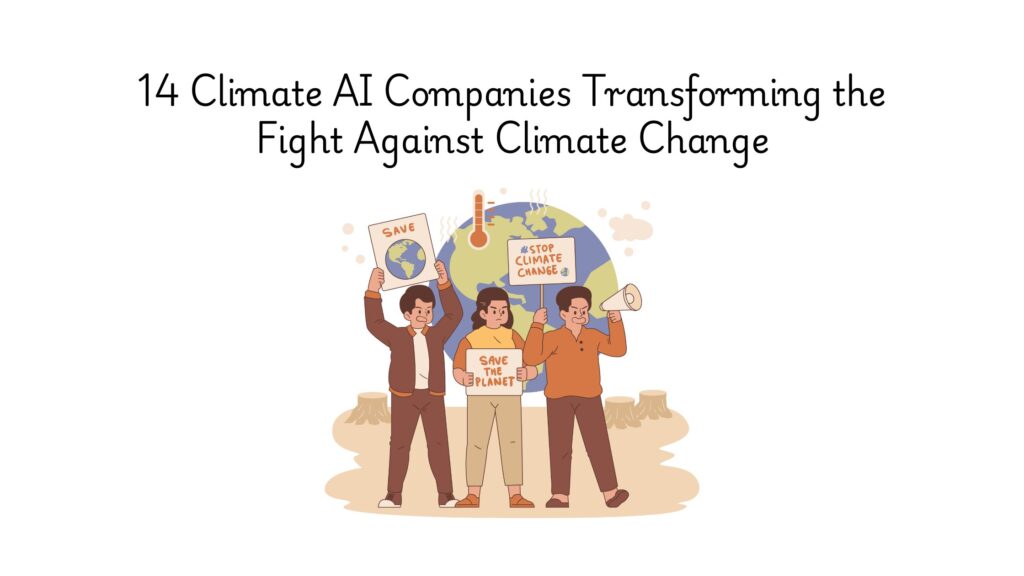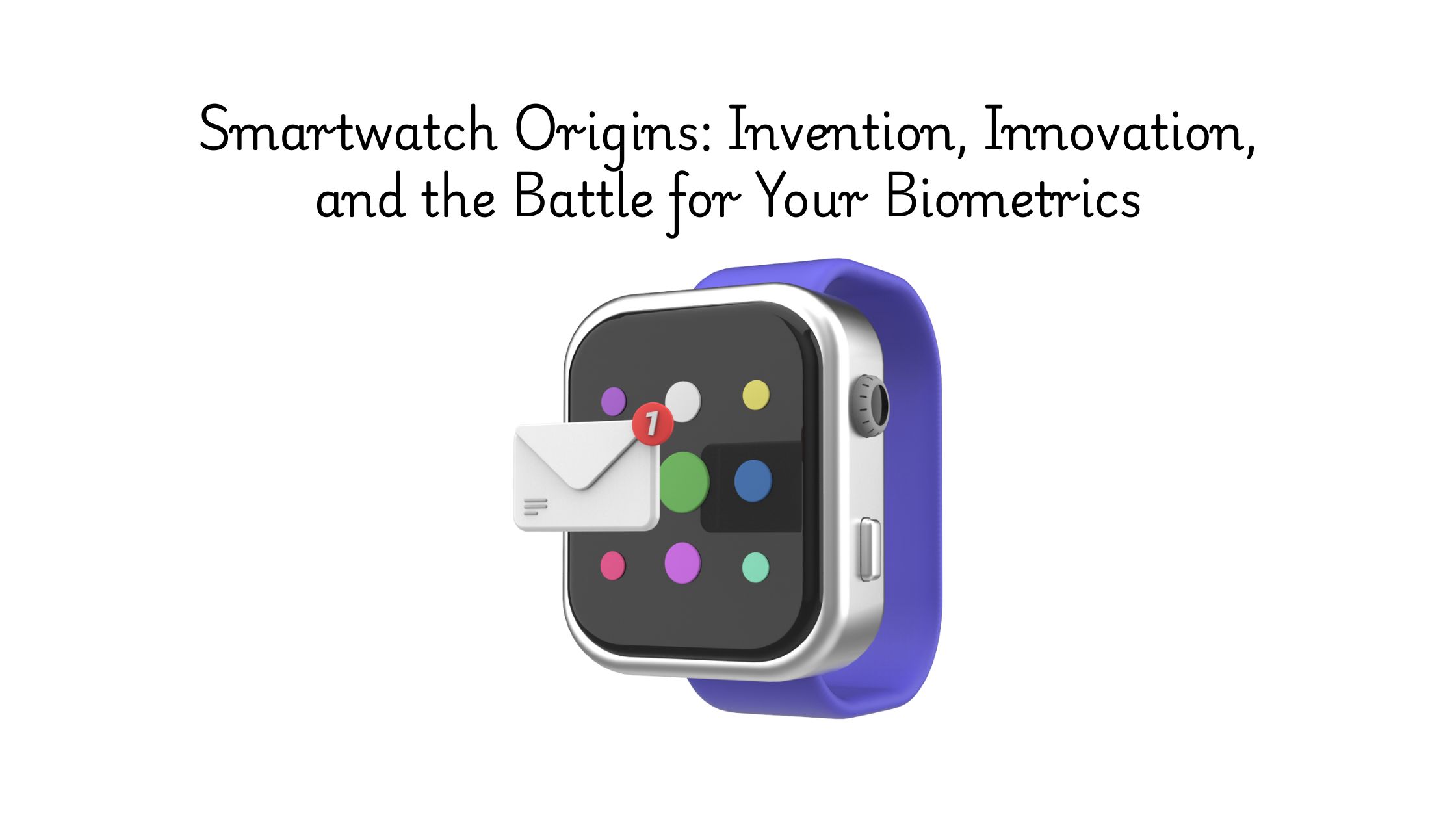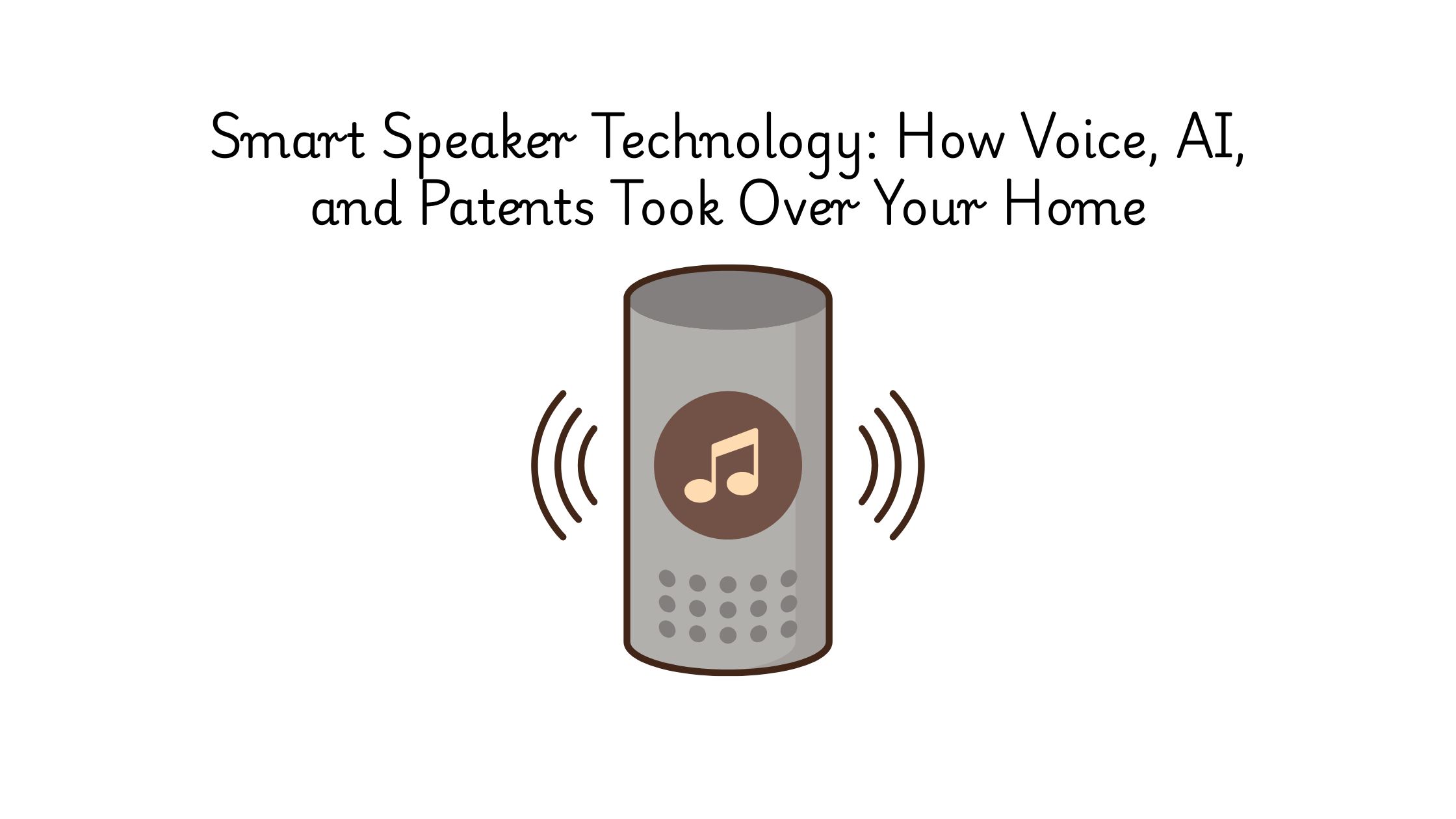Climate AI companies aren’t just innovating. They’re helping humanity buy time.
These companies are fusing artificial intelligence with climate science to predict wildfires, optimize water use, protect crops, and decarbonize entire industries. It’s not theory. Its technology is being deployed at scale to manage the chaos of a warming planet.
And the potential is massive.
A 2023 Google–BCG report found that AI could help eliminate 5–10% of global greenhouse gas emissions by 2030, nearly equal to wiping out the annual emissions of the entire European Union.
In this article, we’ll dive into the 14 most forward-thinking Climate AI companies rewriting what’s possible in climate action with real-world tech, measurable outcomes, and bold ideas.
#1. ClimateAi
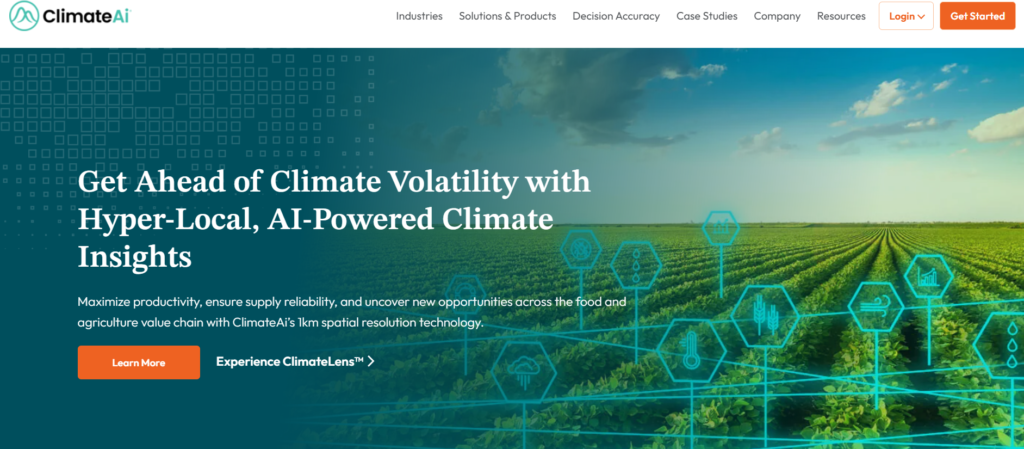
Source: ClimateAi
Founded in 2017 and headquartered in San Francisco, California, ClimateAi is pioneering the application of artificial intelligence to climate risk modeling. Their platform, ClimateLens™, combines AI and advanced machine learning to generate actionable climate insights, aiding businesses and governments in adapting operations and supply chains to climate variability.
The company holds multiple patents, including a U.S. patent for a Generative AI-based approach to weather forecasting, which enhances the resolution and accuracy of local forecasts while reducing computational requirements.
Industry Impact
ClimateAi specializes in building climate resilience across various sectors, notably agribusiness, food & beverage, and finance. By providing precise climate forecasts and risk assessments, they enable proactive adaptation strategies, safeguarding assets and optimizing operations against climate risks.
Key Innovations
#1. ClimateLens™: An AI-driven platform delivering tailored climate insights.
#2. Patented AI Forecasting Models: Proprietary methods for high-resolution weather forecasting.
#3. Sector-Specific Solutions: Customized tools addressing unique climate challenges in targeted industries.
#2. KoBold Metals
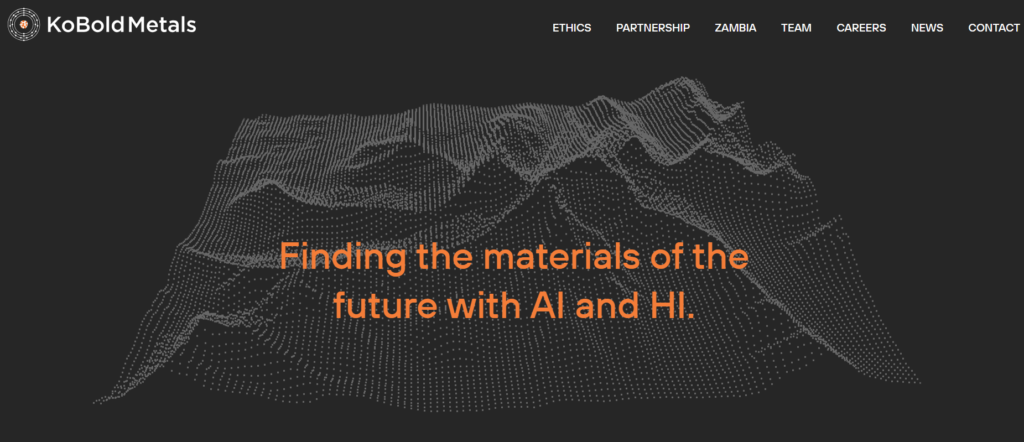
Source: KoBold Metals
Founded in 2018 and headquartered in Berkeley, California, KoBold Metals leverages artificial intelligence to revolutionize the exploration of critical minerals essential for renewable energy technologies. Their proprietary AI platform, TerraShed™, integrates vast geoscientific datasets to predict the locations of cobalt, nickel, copper, and lithium deposits, key components in electric vehicle batteries and renewable energy storage.
Industry Impact
KoBold Metals is transforming the mining industry by reducing the environmental footprint of mineral exploration. Their AI-driven approach minimizes unnecessary drilling and accelerates the discovery of resources vital for the global transition to clean energy.
Key Innovations
#1. TerraShed™: An AI-powered data system aggregating and structuring over a century’s worth of geoscientific data to enhance mineral exploration accuracy.
#2. Machine Prospector: A suite of predictive models interpreting TerraShed™ data to identify optimal drilling targets, thereby increasing efficiency and reducing environmental impact.
#3. Cervest
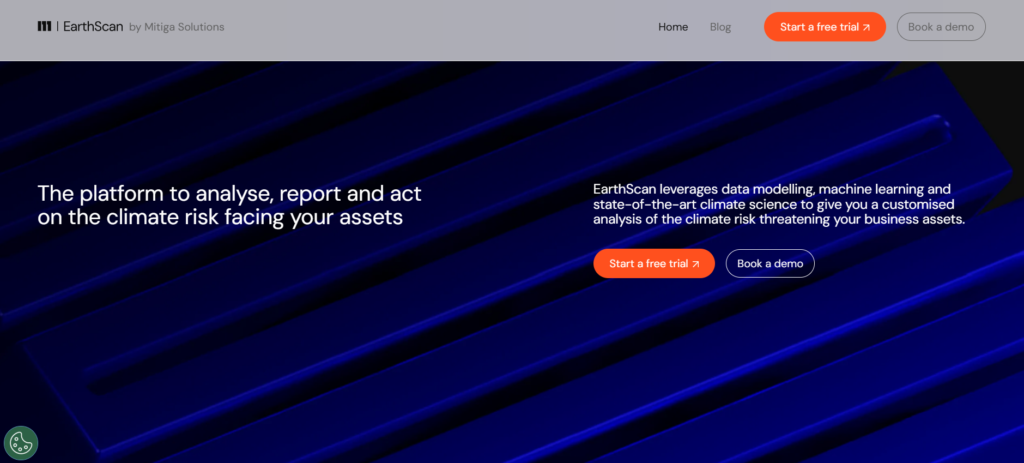
Source: Cervest
Cervest, founded in 2016 and based in London, is redefining climate risk intelligence. The company’s platform, EarthScan, delivers science-backed climate risk assessments for any physical asset on Earth. It uses machine learning, earth science, and probabilistic modeling to evaluate how floods, droughts, heat, and other climate risks will affect assets over time.
With Cervest, enterprises and governments can proactively assess and disclose asset-level climate risk across their portfolios, making it easier to meet sustainability goals and regulatory requirements.
Industry Impact
Cervest empowers industries like real estate, finance, and infrastructure to future-proof assets. It enables better climate risk reporting and smarter capital allocation based on exposure.
Key Innovations
#1. EarthScan climate intelligence platform.
#2. Climate risk quantification at the asset level.
#3. AI-based dynamic risk forecasting models.
#4. Tomorrow.io
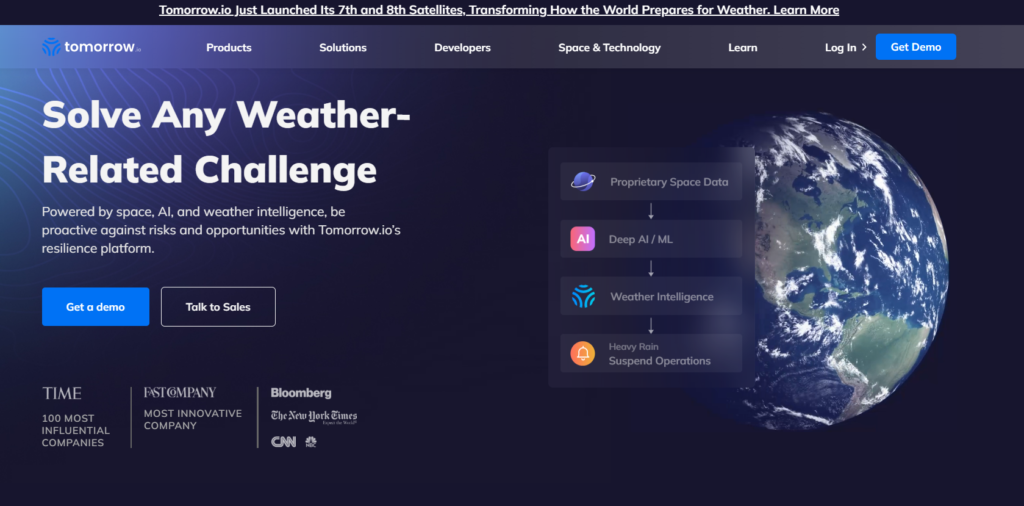
Source: Tomorrow.io
Founded in 2016 and headquartered in Boston, Tomorrow.io is an AI-powered weather and climate intelligence company. Its platform turns complex weather data into actionable insights using proprietary forecasting models and satellite observations. In 2023, the company launched its radar-equipped weather satellites to close global data gaps in climate monitoring.
Tomorrow.io’s AI models enable organizations to predict weather disruptions and adapt operations across aviation, logistics, agriculture, and more, even in regions with limited historical data.
Industry Impact
Tomorrow.io is changing how cities, governments, and enterprises respond to climate volatility. Its tech is used by the U.S. Air Force, Uber, and Delta Airlines to make climate-resilient decisions in real-time.
Key Innovations
#1. AI-powered weather and climate forecasting engine.
#2. Radar-equipped commercial weather satellite constellation.
#3. Climate adaptation tools for operational planning.
#5. Jupiter Intelligence
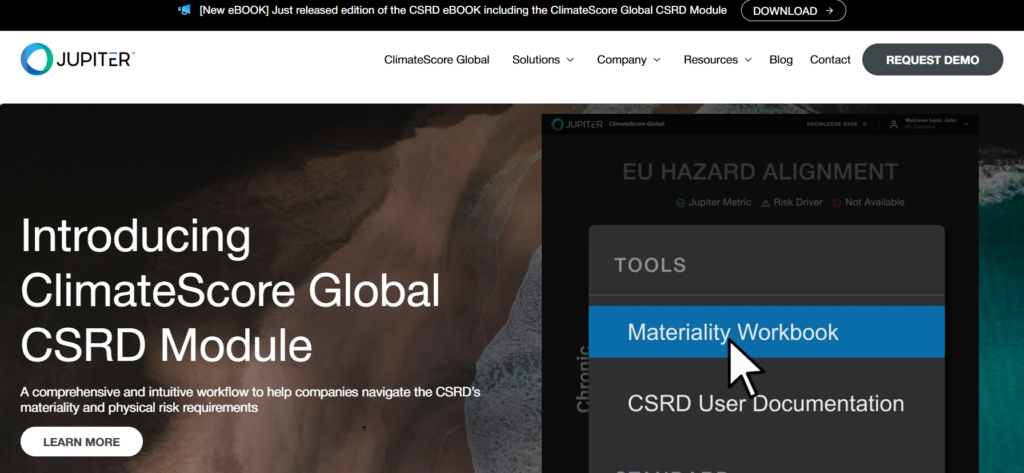
Source: Jupiter Intelligence
Jupiter Intelligence, founded in 2017 and based in Silicon Valley, delivers high-resolution, science-grade climate risk analytics. Its platform uses AI, satellite data, and physical climate models to forecast risks like flooding, wildfires, heatwaves, and wind at the property or infrastructure level.
Jupiter serves asset managers, insurers, utilities, and governments by helping them quantify climate exposure and plan adaptation strategies with confidence. Their models align with global reporting frameworks like TCFD and ISSB.
Industry Impact
Jupiter enables industries to move from reactive disaster response to proactive resilience planning. It helps financial and physical asset owners de-risk portfolios with long-term climate projections.
Key Innovations
#1. ClimateScore Global™ and ClimateScore Infrastructure™ analytics platforms.
#2. AI-enhanced hazard prediction models.
#3. Industry-aligned climate risk reporting integrations.
#6. Kayrros
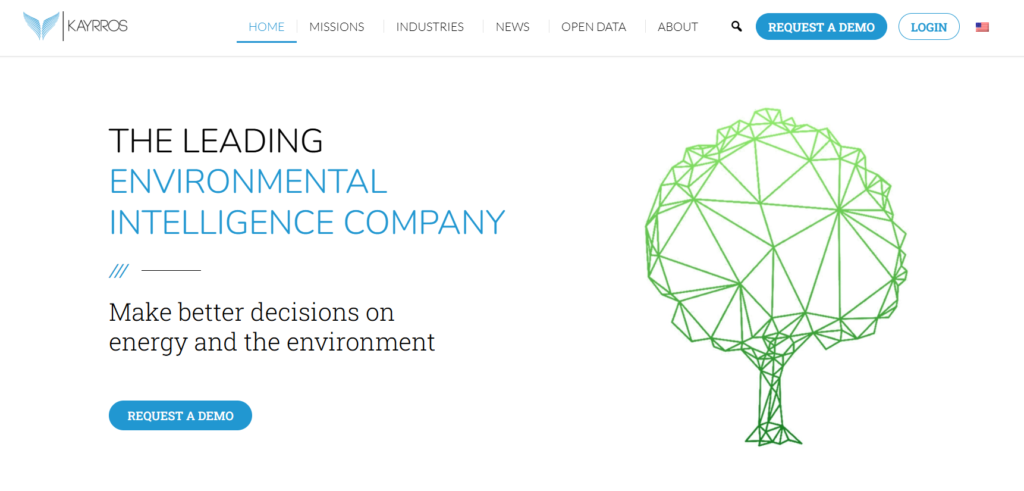
Source: Kayrros
Founded in 2016 and headquartered in Paris, France, Kayrros specializes in environmental intelligence by integrating artificial intelligence with satellite imagery to monitor and analyze environmental and industrial activities. Their platform provides near real-time data on methane emissions, deforestation, and other environmental indicators, aiding in climate change mitigation efforts.
Patent Activity
Kayrros has actively protected its technological innovations through several patents:
20180336693: Method and System for Remotely Measuring the Volume of Liquid Stored in External Floating Roof Tanks: This patent outlines a technique for using Synthetic Aperture Radar (SAR) imagery to remotely measure the volume of liquids in storage tanks, enhancing the accuracy of monitoring industrial liquid storage.
20180137355: Method, Device, and Permanent Storage Memory for Detecting Drilling and/or Hydraulic Fracturing of Hydrocarbon Wells: This patent describes a method for detecting activities such as drilling or hydraulic fracturing by analyzing time-series top-view images. This facilitates more efficient monitoring of hydrocarbon extraction processes.
Industry Impact
Kayrros enhances transparency in emissions tracking and land-use monitoring, providing critical data to regulators and companies to meet climate disclosure mandates and develop informed environmental strategies.
Key Innovations:
#1. Methane Watch Platform: A tool for global emissions tracking.
#2. Satellite-Based AI Models: Systems for monitoring deforestation and wildfire risks.
#3. Carbon Footprint Analytics: Tools for assessing the environmental impact of energy and industrial assets.
#7. Pachama
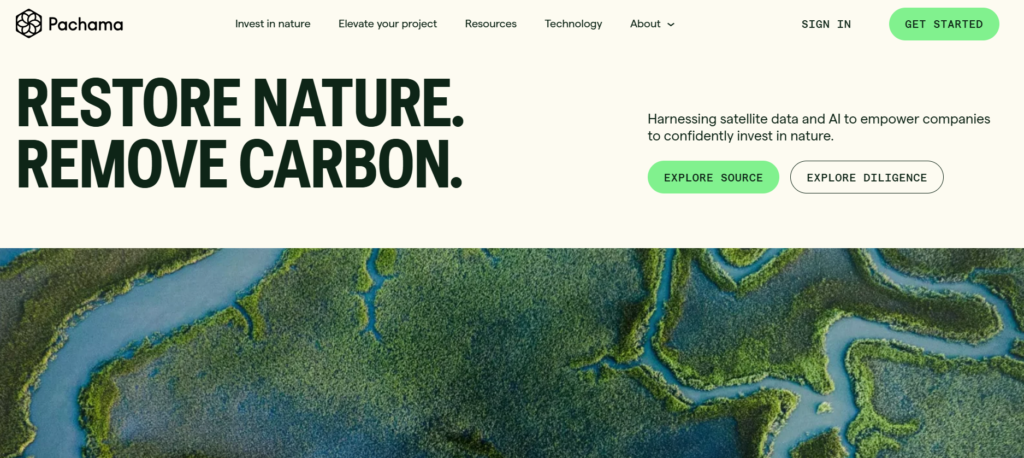
Source: Pachama
Founded in 2018 and based in San Francisco, Pachama leverages artificial intelligence and satellite imagery to enhance the transparency and efficiency of forest carbon markets. Their platform utilizes machine learning algorithms to monitor reforestation and conservation projects, ensuring accurate carbon credit verification and promoting investment in nature-based climate solutions.
Patent Activity
Specific patent information for Pachama is not publicly disclosed. However, the company has secured trademarks, such as “Pachama Originals,” indicating active efforts to protect their intellectual property.
Industry Impact
Pachama is restoring trust in carbon markets by providing rigorous, real-time monitoring of carbon sequestration in forests, thereby facilitating credible carbon offset investments.
Key Innovations
#1. AI-Powered Forest Carbon Verification: Enhances the accuracy of carbon credit assessments.
#2. Satellite and LiDAR-Based Biomass Estimation: Provides precise measurements of forest growth and health.
#3. Carbon Marketplace Platform: Connects investors with verified reforestation and conservation projects.
#8. VelocityEHS
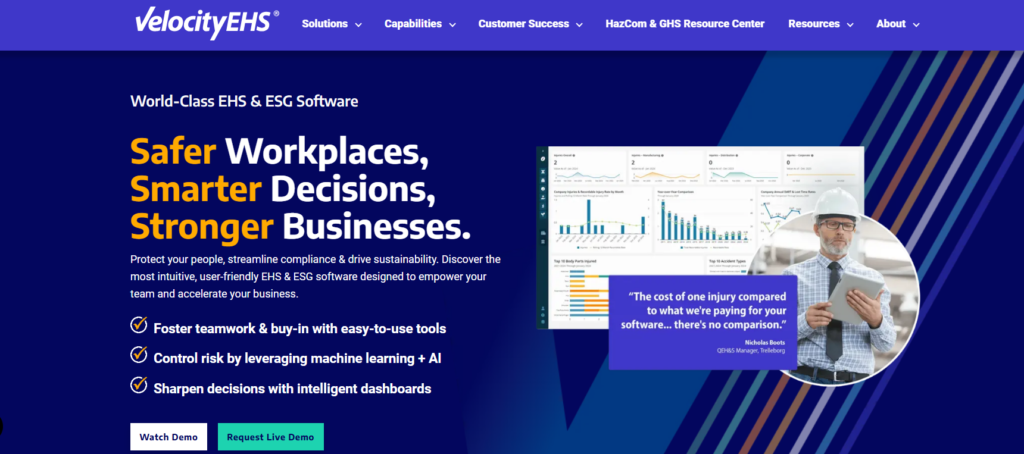
Source: VelocityEHS
Founded in 1996 and headquartered in Chicago, Illinois, VelocityEHS specializes in environmental, health, safety (EHS), and environmental, social, and governance (ESG) software solutions. The company integrates artificial intelligence and machine learning into its platform to help organizations identify and mitigate workplace hazards, enhancing safety and sustainability efforts.
Patent Activity
The U.S. Patent and Trademark Office has awarded VelocityEHS five patents for its pioneering use of artificial intelligence (AI) and machine learning (ML) to help prevent workplace injuries and incidents. These patents underscore the company’s commitment to leveraging AI for proactive risk management and operational excellence.
Industry Impact
By embedding AI into EHS and ESG practices, VelocityEHS enables organizations to proactively address environmental and safety challenges, contributing to more sustainable and compliant operations.
Key Innovations
#1. AI-driven risk assessment tools.
#2. Machine learning models for predictive safety analytics.
#3. Comprehensive EHS and ESG management platform.
#9. Verdigris Technologies
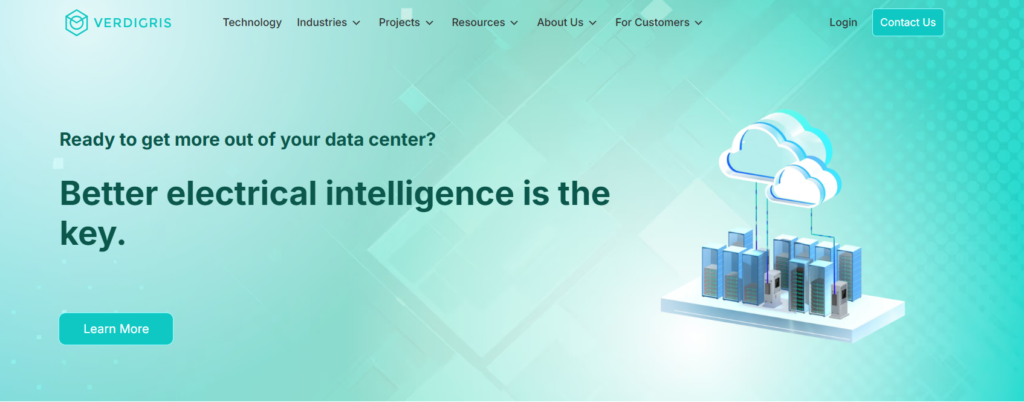
Source: Verdigris Technologies
Founded in 2011 and headquartered in Mountain View, California, Verdigris Technologies specializes in energy management solutions for commercial and industrial buildings. Their AI-powered platform utilizes proprietary hardware and software to monitor and analyze energy consumption, enabling clients to enhance energy efficiency and reduce operational costs.
Patent Activity
Specific patent information for Verdigris Technologies is not publicly disclosed. However, their innovative approach to energy management, combining advanced AI algorithms with IoT sensors, has been recognized in the industry.
Industry Impact
Verdigris Technologies provides facilities managers with detailed insights into energy usage, allowing for proactive maintenance and optimized energy consumption. Their solutions contribute to sustainability efforts by reducing energy waste in large-scale operations.
Key Innovations
#1. AI-Driven Energy Analytics: Utilizes machine learning to provide actionable insights on energy consumption.
#2. IoT Sensor Integration: Deploys smart sensors to monitor electrical circuits in real time.
#3. Predictive Maintenance Tools: Identifies potential equipment failures before they occur, reducing downtime.
#10. BrainBox AI
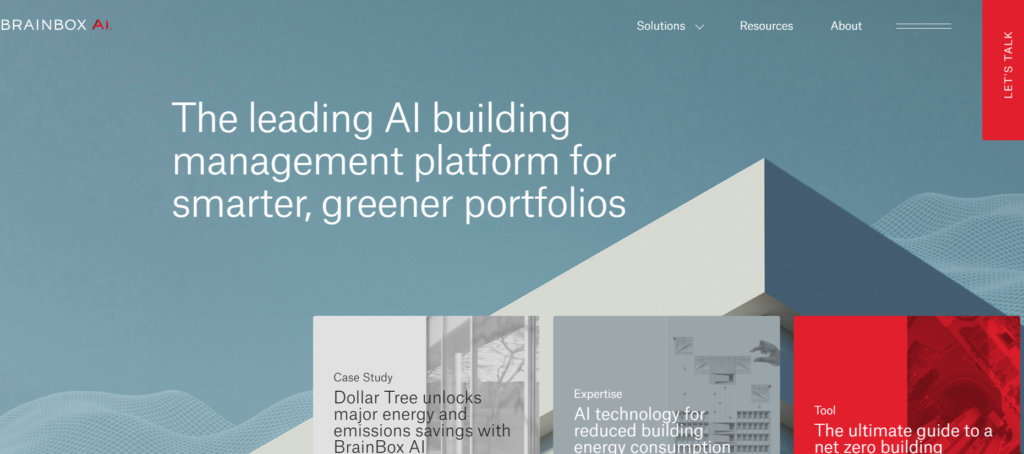
Source: BrainBox AI
Founded in 2017 and headquartered in Montreal, Canada, BrainBox AI brings artificial intelligence to the world of commercial real estate. Its technology integrates with a building’s HVAC system to predict and optimize energy usage in real-time, using deep learning, cloud computing, and data from IoT sensors.
The company claims it can reduce a building’s carbon footprint by up to 40% and HVAC energy costs by up to 25%, making it one of the most impactful solutions for decarbonizing buildings at scale.
Patent Activity
BrainBox AI has filed patents on real-time optimization of HVAC operations using predictive analytics and reinforcement learning. Their IP focuses on dynamically controlling energy-intensive systems based on occupancy patterns, weather forecasts, and energy pricing.
Industry Impact
BrainBox AI enables large-scale emissions reductions in the built environment, one of the largest contributors to climate change, without requiring new infrastructure.
Key Innovations
#1. AI-driven HVAC optimization engine.
#2. Predictive energy control using reinforcement learning.
#3. Cloud-integrated building automation platform.
#11. The Ocean Cleanup
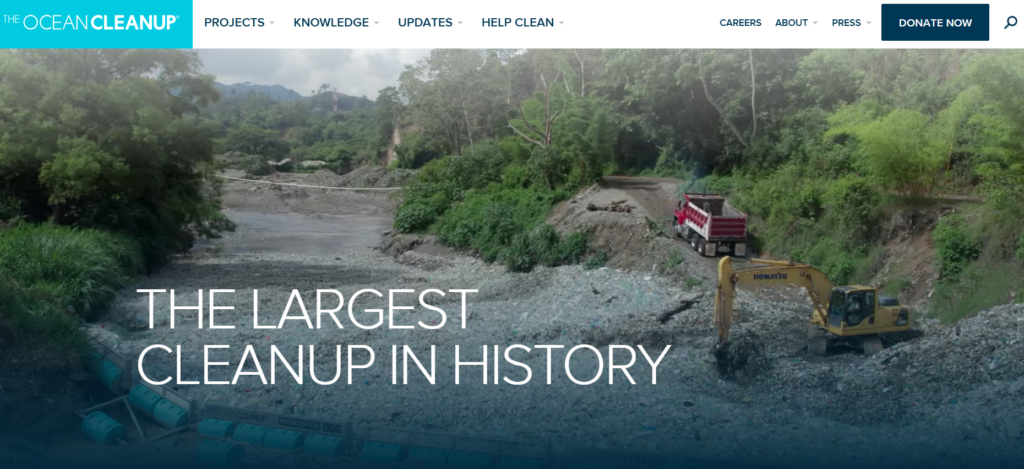
Source: The Ocean Cleanup
Founded in 2013 and headquartered in Rotterdam, Netherlands, The Ocean Cleanup is a nonprofit developing advanced technologies to rid the world’s oceans of plastic. They deploy AI-powered camera systems mounted on ships and drones to detect, classify, and quantify marine plastic debris in real-time.
Their data guides cleanup operations and upstream prevention strategies, creating a feedback loop between technology, environmental science, and policy action.
Patent Activity
The Ocean Cleanup holds patents related to floating barrier systems and data-driven plastic capture technologies. Their AI work supports real-time plastic detection and system navigation, though patents are primarily in environmental engineering rather than machine learning directly.
Industry Impact
The Ocean Cleanup is tackling one of the most visible symptoms of environmental degradation. Their work has removed thousands of tons of plastic from the Great Pacific Garbage Patch and rivers globally.
Key Innovations
#1. Interceptor™ systems for autonomous river cleanup.
#2. AI-powered plastic detection and mapping.
#3. Patented floating barrier systems for ocean debris removal.
#12. Greyparrot
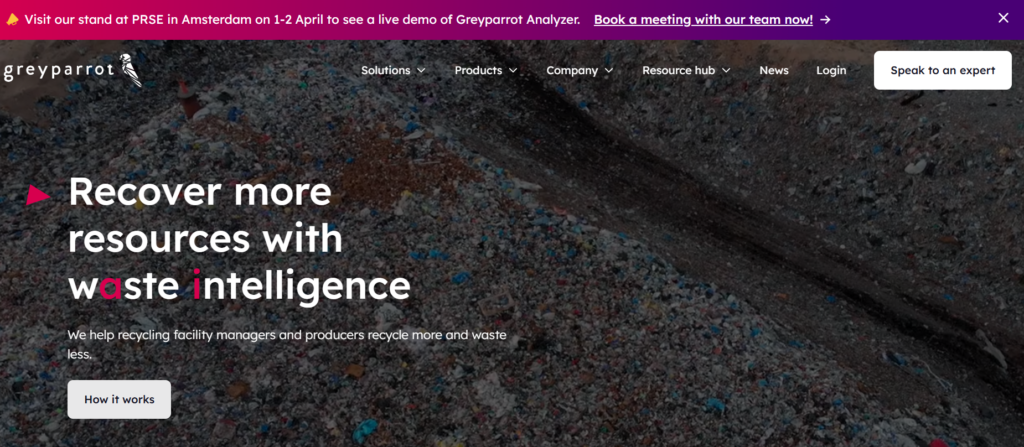
Source: Greyparrot
Founded in 2019 and based in London, Greyparrot uses AI and computer vision to automate waste recognition and analytics in recycling facilities. Their system analyzes waste streams in real-time, helping facilities identify material types, track contamination, and improve sorting, all without interrupting operations.
Their platform, Waste Analytics, provides transparency across the waste value chain and helps increase recovery rates of recyclable materials.
Patent Activity
Greyparrot has filed patents on computer vision systems for automated waste classification and AI models optimized for material detection in high-speed industrial environments. Their innovation sits at the intersection of climate tech and industrial automation.
Industry Impact
Greyparrot is transforming waste management with AI, helping to reduce landfill dependency, improve recycling economics, and cut emissions from improperly handled waste.
Key Innovations
#1. AI-powered Waste Analytics platform.
#2. Real-time material recognition using deep learning.
#3. Patents in computer vision for waste classification.
#13. Climate TRACE

Source: Climate TRACE
Launched in 2020 as a global coalition co-founded by Al Gore, Climate TRACE uses AI, machine learning, and satellite data to track greenhouse gas emissions from nearly every country and major emitting facility on Earth. Unlike self-reported emissions data, Climate TRACE offers independent, near real-time monitoring of over 70,000 individual sources.
Governments, NGOs, and companies use their open-access database to develop better climate policies, compliance strategies, and ESG disclosures.
Patent Activity
As a nonprofit coalition, Climate TRACE does not hold patents, but participating members and tech partners contribute proprietary AI models for emissions detection. The project leverages advanced image recognition, geospatial analysis, and anomaly detection, often built on patented frameworks developed by coalition members.
Industry Impact
Climate TRACE is bringing unprecedented transparency to global emissions tracking. It’s helping shift climate accountability from estimates to verifiable data.
Key Innovations
#1. AI-driven emissions detection across sectors and geographies.
#2. Open-access global emissions database.
#3. Integration of satellite, sensor, and industrial data for real-time monitoring.
#14. Yayzy
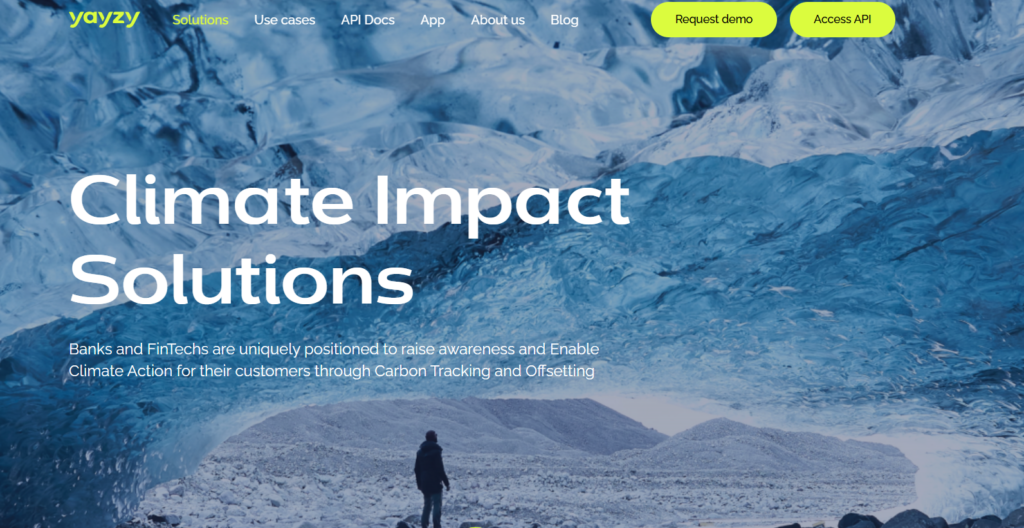
Source: Yayzy
Founded in 2019 and based in London, Yayzy developed a mobile app that uses AI to calculate the carbon footprint of users’ financial transactions. By analyzing spending behavior in real-time, the app estimates the environmental impact of purchases and offers offsetting options, sustainability tips, and personalized insights.
Yayzy integrates directly with banking APIs to make climate action effortless for consumers, bridging the gap between awareness and action at the individual level.
Patent Activity
Yayzy has not disclosed specific patents but has developed proprietary algorithms for transaction-based emissions estimation. Their technology is built on emissions factor databases, machine learning models, and payment categorization engines tailored to environmental analytics.
Industry Impact
Yayzy is turning everyday banking into a climate-conscious activity. By enabling consumers to visualize and act on their carbon footprint, the company is helping shift climate responsibility from just corporations to individuals.
Key Innovations
#1. AI-powered carbon footprinting for financial transactions.
#2. Real-time sustainability insights for consumers.
#3. Fintech integrations promoting climate-positive behavior.
Conclusion: Climate AI Innovation and the Power of Patent Intelligence
The top 14 Climate AI companies we’ve explored are doing more than fighting climate change; they’re redefining how industries operate in a warming world. From AI-optimized buildings to satellite-powered emissions tracking, these pioneers are turning data into climate action at scale.
But in a space moving this fast, how do you separate real innovation from hype?
Patent activity tells a deeper story. It reveals who is developing proprietary technology, protecting AI breakthroughs, and setting the pace for climate adaptation.
That’s where the Global Patent Search Tool comes in. Unlike traditional databases, this AI-powered platform helps you:
1. Find relevant climate AI patents by simply describing a concept.
2. Track innovation over time using priority dates and filing trends.
3. Understand how patent features align with real-world technologies.
4. Discover hidden links between climate tech, AI models, and hardware systems.
Whether you’re a sustainability officer evaluating partnerships, a policymaker tracking tech maturity, or an investor spotting the next climate leader, the Global Patent Search Tool gives you a competitive edge.
If you want to explore the Intellectual Property (IP) driving the future of Climate AI, start your search today with the Global Patent Search Tool.

